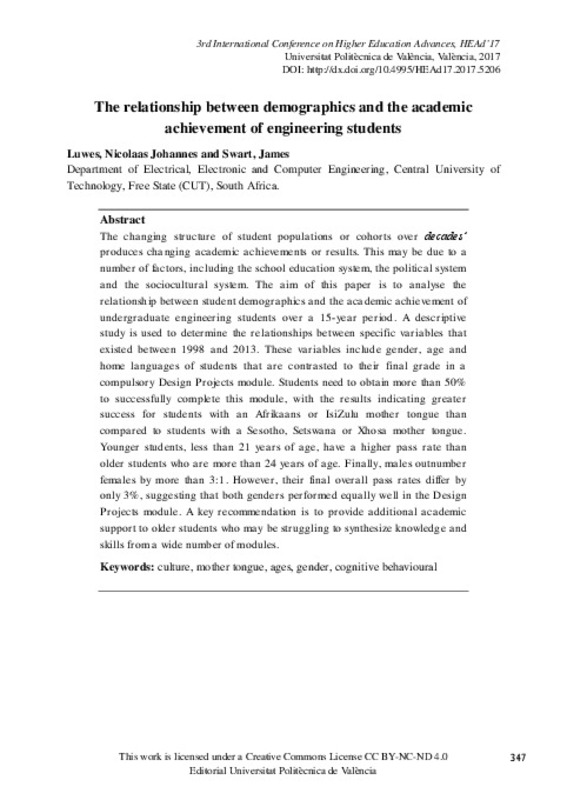JavaScript is disabled for your browser. Some features of this site may not work without it.
Buscar en RiuNet
Listar
Mi cuenta
Estadísticas
Ayuda RiuNet
Admin. UPV
The relationship between demographics and the academic achievement of engineering students
Mostrar el registro sencillo del ítem
Ficheros en el ítem
| dc.contributor.author | Luwes, Nicolaas
|
es_ES |
| dc.contributor.author | Swart, James
|
es_ES |
| dc.date.accessioned | 2018-06-25T07:04:35Z | |
| dc.date.available | 2018-06-25T07:04:35Z | |
| dc.date.issued | 2017-06-26 | |
| dc.identifier.isbn | 9788490485903 | |
| dc.identifier.uri | http://hdl.handle.net/10251/104596 | |
| dc.description.abstract | [EN] The changing structure of student populations or cohorts over decades’ produces changing academic achievements or results. This may be due to a number of factors, including the school education system, the political system and the sociocultural system. The aim of this paper is to analyse the relationship between student demographics and the academic achievement of undergraduate engineering students over a 15-year period. A longitudinal descriptive study is used to determine the relationships between specific variables that existed between 1998 and 2013. These variables include gender, age and home languages of students that are contrasted to their final grade in a compulsory Design Projects module. Students need to obtain more than 50% to successfully complete this module, with the results indicating greater success for students with an Afrikaans or IsiZulu mother tongue than compared to students with a Sesotho, Setswana or Xhosa mother tongue. Younger students, less than 21 years of age, have a higher pass rate than older students who are more than 24 years of age. Finally, males outnumber females by more than 3:1. However, their final overall pass rates differ by only 3%, suggesting that both genders performed equally well in the Design Projects module. A key recommendation is to provide additional academic support to older students who may be struggling to synthesize knowledge and skills from a wide number of modules | es_ES |
| dc.format.extent | 9 | es_ES |
| dc.language | Inglés | es_ES |
| dc.publisher | Editorial Universitat Politècnica de València | es_ES |
| dc.relation.ispartof | Proceedings of the 3rd International Conference on Higher Education Advances | es_ES |
| dc.rights | Reconocimiento - No comercial - Sin obra derivada (by-nc-nd) | es_ES |
| dc.subject | Higher Education | es_ES |
| dc.subject | Learning | es_ES |
| dc.subject | Educational systems | es_ES |
| dc.subject | Teaching | es_ES |
| dc.subject | Culture | es_ES |
| dc.subject | Mother tongue | es_ES |
| dc.subject | Ages | es_ES |
| dc.subject | Gender | es_ES |
| dc.subject | Cognitive behavioural | es_ES |
| dc.title | The relationship between demographics and the academic achievement of engineering students | es_ES |
| dc.type | Capítulo de libro | es_ES |
| dc.type | Comunicación en congreso | es_ES |
| dc.identifier.doi | 10.4995/HEAD17.2017.5206 | |
| dc.rights.accessRights | Abierto | es_ES |
| dc.description.bibliographicCitation | Luwes, N.; Swart, J. (2017). The relationship between demographics and the academic achievement of engineering students. En Proceedings of the 3rd International Conference on Higher Education Advances. Editorial Universitat Politècnica de València. 347-355. https://doi.org/10.4995/HEAD17.2017.5206 | es_ES |
| dc.description.accrualMethod | OCS | es_ES |
| dc.relation.conferencename | Third International Conference on Higher Education Advances | es_ES |
| dc.relation.conferencedate | June 21-23,2017 | es_ES |
| dc.relation.conferenceplace | Valencia, Spain | es_ES |
| dc.relation.publisherversion | http://ocs.editorial.upv.es/index.php/HEAD/HEAD17/paper/view/5206 | es_ES |
| dc.description.upvformatpinicio | 347 | es_ES |
| dc.description.upvformatpfin | 355 | es_ES |
| dc.type.version | info:eu-repo/semantics/publishedVersion | es_ES |
| dc.relation.pasarela | OCS\5206 | es_ES |








